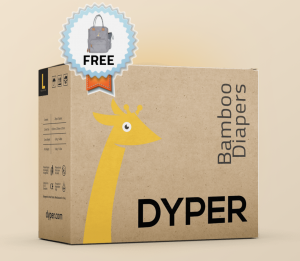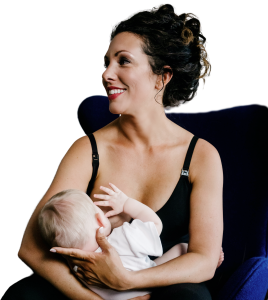Do you know the best way to manage nipple pain while breastfeeding? Well, one of the answers is to avoid pain while breastfeeding and pumping in the first place!
You might be wondering, “How can I avoid nipple pain while breastfeeding and pumping?” In a word: Education!
Setting yourself up for pain-free breastfeeding happens before you ever go into labor. In my many years working as a labor and delivery nurse and Certified Nurse Midwife, I can honestly tell you that most nipple injuries happen in the first 24 hours after birth.
Why? Lack of knowledge, not enough support, sheer exhaustion, and a defeated mindset. It’s one of the first topics I cover in my Breastfeeding Basics Class!
Think about it this way — the first time the baby latches, he or she has a shallow latch, which hurts “a little bit.” But how would you know it’s not normal if you’ve never done it before? You don’t know what it’s supposed to feel like, so you “muscle through it.”
NOPE. Baaaaaad idea.
One tiny nipple injury can turn into a huge nipple injury when you are using those nips every two to three hours for the foreseeable future.
If you prepare and hold a few concrete concepts about breastfeeding close to your chest (no pun intended) before the first feeding, you will set yourself up for pain-free success.
Here are 5 foolproof ways to avoid nipple pain while breastfeeding and pumping.
1.) Get to know your nipples
If you are still pregnant, take a good, hard look at your nipples. What kind of nipples do you have? (Yes, this varies!)
No matter what kind of nipples you have, you will most likely be able to breastfeed. There are very few exceptions to this rule of nature. However, there are some nipples that will require troubleshooting for a good latch. Check out my podcast episode called “Special Nipples” to learn even more about why your nipples are FINE.
My digital courses, will help you identify your nipple type and learn latching tips for your specific kind of nipple. Be sure to sign up for my email list to get updates about the course launch!
2.) Learn breastfeeding position basics
Position is essential when it comes to getting a good latch. A weird position may cause a baby to arch its back or crane its neck to reach the nipple. These positions will pull the nipple down or to the side, leading to nipple pain.
Visuals are the best way to learn breastfeeding positions, and there are lots of them in my course. But here are a couple tips to get you started.
- Baby should be belly-to-belly with you. Tummy to Mummy! No one wants to eat a meal with his or her head turned to the side.
- Make sure the baby’s airway is straight. If you’re worried about suffocating your baby with your large breast, pull the baby’s bottom closer to your body. This motion will take the pressure off of baby’s face and allow baby to breathe more easily.

3.) Understand what makes a good latch
Point the nipple toward the baby’s nose, and he or she will inevitably open wide and latch on. That nice, wide-open mouth — approximately 140-degree angle — is going to ensure that your baby is breastfeeding and not “nipple feeding.” If your baby sucks on only the tip of your nipple, you will have pain and bruising. Potentially even blistering and cracking later.
If you feel that your baby has a shallow latch, check underneath to ensure that the bottom lip isn’t tucked in. Both lips need to be flanged out around your nipple and areola. If the bottom lip is tucked in, use your finger to pull down slightly on the chin and pop that bottom lip out.
If the latch feels painful at all, release the suction by sticking your finger between your nipple and the baby’s mouth. Don’t just pull the baby off! That little sucker will try to take your nipple with them! Ouchie. Reposition and try again.
4.) Reduce the chance of engorgement
Engorgement is swelling from labor/IV fluids combined with incomplete milk removal. When the breasts are too full of this fluid, they can get hard. It’s like trying to latch a hungry baby onto a kneecap! Not impossible, but very difficult and FRUSTRATING.
Engorgement can also create a situation where baby can’t achieve a deep latch and only sucks on the tip of your nipple. Again, “nipple feeding” will cause injury.
The best way to prevent engorgement is to nurse often in the beginning. More specifically, do NOT supplement in the first 24 hours. AT ALL. (This does not include medical emergencies or preterm babies, of course.) If you have a healthy baby who is just not getting the hang of breastfeeding or is very sleepy and can’t stay awake for a feeding, don’t worry about it. Do NOT supplement with a bottle during this time.
5.) Make sure your pumping equipment is the correct size
If you plan to be a pumping parent, please know that flanges come in different sizes. I feel very passionately about this topic because I used a breast pump flange that was too large for eight months.
I am a lactation consultant, and it took me eight months to realize that the wrong flange size was the source of my deep breast pain. What in the actual heck?! If I can make this easy mistake, that means you can as well.
Double-check equipment sizes before pumping for the first time. My lactation courses have resources that will help you measure your breast and nipple and find the appropriate flange size. I also have a podcast episode on how to clean and manage your pumping equipment, which you can find HERE!
Are you ready to learn more about pain-free breastfeeding? Join my free Facebook group called “Breastfeeding for Busy Moms” if you haven’t already. Or, schedule a private consult with me HERE!






